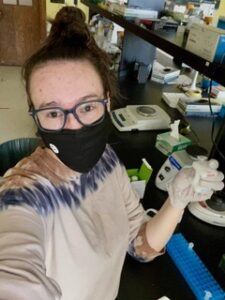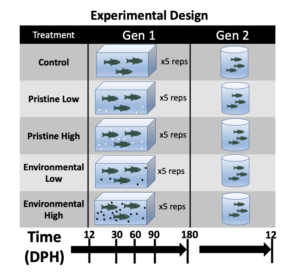**The AGA grants EECG Research Awards each year to graduate students and post-doctoral researchers who are at a critical point in their research, where additional funds would allow them to conclude their research project and prepare it for publication. EECG awardees also get the opportunity to hone their science communication and write posts over their grant tenure for the AGA Blog. In the first in the series, our EECG awardees write about their research and their interests as an ’embarkation’.**

About the Blog Author: Miranda Wade is a conservation geneticist and PhD candidate in the Meek Lab at Michigan State University. She works on assessing the various effects of anthropogenic change across different ecosystems. Find Miranda on twitter @mirandaconcolor or via her or her lab’s website.
Humans often have unexpected, or unexpectedly large, impacts on their environments. These impacts are both planned and unplanned, and often our mitigation and mediation strategies fall short of the scope of the disturbance. While the Anthropocene is largely recognized as an era of global environmental change, many questions remain over how species adapt and respond to these effects. To this end, I built my dissertation around the question of, “What are the effects of anthropogenic change on species of conservation concern?” To further explore this topic, I split my research into distinct pieces using two unique systems.
In my first system, I assessed the “primary” effects of anthropogenic change, where alternative energy development has directly impacted an ecosystem and led to habitat fragmentation in a desert landscape. My paper over this is out for review, so hopefully I will be published soon!

To determine “secondary” effects, where anthropogenic change has indirect, unintended, and often unforeseen consequences, I collaborated with the Rochman lab at the University of Toronto on an experiment quantifying the molecular effects of microplastic exposure. We tested the effects of two microplastic concentrations, reflecting both current and predicted future conditions, using both pristine and environmental plastic gathered from Lake Ontario. We raised two generations of fathead minnows, a toxicological model organism, under each treatment, sampling at several different developmental stages. Kennedy Bucci completed most of this work for her ecotoxicological work in the Rochman Lab and has published some of her work here. Uniquely, we sampled the second generation of minnows to determine the occurrence of any intergenerational effects. I will address the following questions: 1) does the magnitude of the effect of microplastics on gene transcription vary with plastic concentration/life stage, 2) if there are changes in DNA methylation patterns attributed to the microplastics, are these effects intergenerational, and 3) how much of the observed effect is due to exposure to the pristine microplastic versus the environmental plastic containing absorbed chemicals?
Currently, samples are undergoing preparation for reduced-representation bisulfite sequencing using novel techniques that are aimed at reducing library cost. The goal of this work is to determine changes in methylation patterns between the treatments. I have already prepared and analyzed a library of mRNA samples, looking for differential gene expression. I am in the process of determining what genes and gene modules are modified and the potential implications. I hope our findings from this study will increase our understanding of the effect, and the persistence of these effects, of microplastic pollution on aquatic organisms. The results of this study will reach across species and ecosystems, increasing our knowledge of the molecular response of species to anthropogenic pollution. In an era of unprecedented change, I hope my research will help illuminate some of the ways humans interact with and affect the incredible biodiversity that surrounds us, and to help move knowledge towards better coexistence with the natural world.



